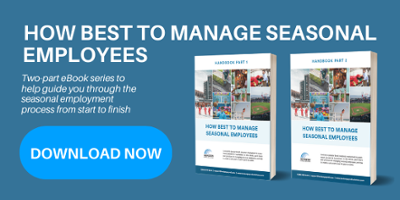Ask the Expert: Absenteeism - A Symptom You Can’t Afford to Ignore
Employee absences are inevitable. Scheduled or not, legitimate or not, absences mean less work completed as time and money go to paid sick time and overtime, picking up the slack, training a sub, or bringing in a temp. And don’t forget “soft” costs like increased workload, coworker resentment and reduced productivity. Absenteeism may be an unavoidable part of life at work, but it can be managed. The time you spend tracking attendance helps you find ways to improve it. Besides, what you learn about your employees’ absenteeism could be like the canary in the coalmine – a sign that something else is wrong.
Track and Analyze
Just like watching your budget helps you control spending and plan ahead, tracking attendance highlights lost time and money and areas for improvement. You might not even realize the impact absences have on your business unless you take time to analyze your records.
Track all employee absences: Sick and vacation leave, time clocked in and out, partial shifts and breaks. Watch for patterns of absence (especially around holidays), frequency and duration of missed days and planned versus unplanned time off. For record keeping, create a spreadsheet, buy software or work with a partner. While many absences are legitimate, your goal is to identify the ones that aren’t.
What’s The Underlying Cause?
If you uncover a troubling pattern, what’s causing it? Everyone gets a cold or stays home to let the plumber in at some point, but if missing work becomes routine or predictable, that’s a symptom you shouldn’t ignore. Chronic absenteeism is a sign of underlying problems including ongoing physical or mental illness, disability, unmet child or eldercare needs, burnout, a sense of entitlement, a toxic work environment (think harassment and bullying) or even an inadequate leave program.
Taking Action
Start with a policy that’s fair, well-communicated and enforced. Spell out types and amounts of available leave and how it's accrued, consequences for unexcused absence and any program of counseling or progressive discipline for chronic attendance issues. And be consistent! “Employees notice when employees are treated differently and this disparate treatment creates problems with motivation and engagement,” says The Balance.
Your policy must follow rules in the Family and Medical Leave Act (FMLA) and Americans with Disabilities Act (ADA). Also check your “state or local leave laws to see if they provide leave that runs concurrently with the FMLA or if such laws provide greater coverage in some respects,“ advises HR Hero.
That said, you still must view employees as individuals and consider the merits of each case when granting leave. HR Hero says to be safe, companies should always document “what these operational differences are, as far as why it gave Mary in payroll three extra months of leave after her FMLA leave exhausted, but when Gene in the warehouse wanted two extra months, they told him ‘no.’”
Encourage Attendance
Managing absence is actually about encouraging attendance. Train supervisors to take a proactive approach to managing unplanned absences. According to The Balance, employees should call “directly to the supervisor who is trained to manage absenteeism” and supervisors need to tell them “he or she will be missed and … the impact of their absence on the workplace.” Supervisors should follow up by giving employees a warm welcome when they return and reinforcing that their absence impacts rest of team.
You can also encourage attendance with incentive programs like earned time off, perfect attendance awards, and public recognition.
Foster Employee Health and Wellness
The Integrated Benefits Institute (IBI) advises looking at your business strategy “in a way that identifies how illness impacts employees’ ability to show up for work and put in their top performance, and how this, in turn, impacts critical business outputs.” In other words a sick, stressed or chronically unwell employee has a harder time doing the job to their best ability.
It’s obvious that spreading the flu to coworkers isn’t a productive business practice. But other health issues affect productivity too. For example, IBI research indicates that “for every 1,000 U.S. employees, mood disorders (such as depression) in the workforce costs about $232,000 in excess health care treatments and lost work time.” Stress due to personal, family or financial challenges follow employees to work and affect performance too.
Employee Assistance Programs and wellness programs assist employees who struggle with these issues. Program costs are usually covered by the employer and programs extend to the employees’ dependents.
Be Flexible and Supportive
We’ve all been there: The babysitter gets sick the day of your big deadline, or the cable company service window overlaps with a project kickoff. Making it easier to be at work supports employees and increases odds they’ll get the job done. Try offering flexible schedules, job sharing, flex time or the allow them to make up time before or after a planned absence. Telecommuting or work-from-home programs also let employees stay productive “at work” even if they can’t make it into the office.
According to the Job Accommodation Network, “an injured worker is less likely to return to work the longer he or she is on leave.” If employees’ life circumstances have changed, e.g., disability, physical or mental illness, it can be a challenge to transition back onto the job. Aid the transition and increase productivity with a return-to-work or light-duty program. The Society for Human Resource Management (SHRM) explains, “light duty typically involves excusing an employee from performing certain tasks that he or she would normally perform. Limited duty may reduce the number of hours that someone normally works in a day. Modified duty may eliminate some tasks and replace them with others more suitable for the employee’s physical limitations in the employee’s normal position.”
Another advantage of this kind of support? Employees notice it and know they’re a valued contributor to their workplace. According to the Harvard Business Review, “disengaged workers had 37% higher absenteeism,” based on studies by Gallup and Queens School of Business. Managers can counter disengagement by building social connections with employees, expressing empathy and being helpful whenever possible.
How are you dealing with absenteeism? Looking for a partner who always shows up? Horizon Payroll Solutions has resources that can help. How Best to Manage Seasonal Employees Handbook eBook series addresses time and attendance for your seasonal workforce.


 HR Support
HR Support Time & Attendance
Time & Attendance Hiring & Onboarding
Hiring & Onboarding
